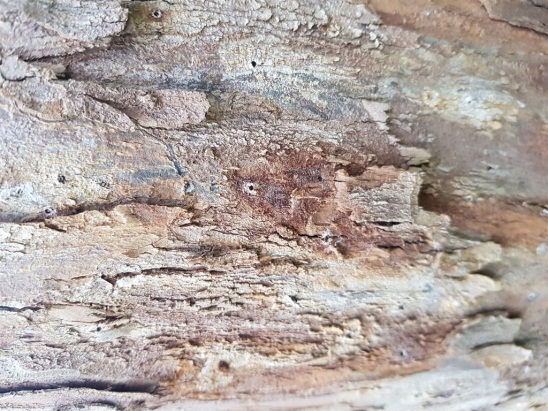The Asian ambrosia beetle, also called the granulate ambrosia beetle, is an invasive pest first introduced in Carolina peach orchards in the 1970s. They have since spread all over the United States and caused many millions of dollars in damages. Several tree species are susceptible to attack, including oak, dogwood, maple, cherry, peach, crape myrtle, hickory and many more.
Ambrosia beetles are small wood-boring insects that spend most of their lives inside trees. This makes it difficult to control. Females emerge for a short time in spring to find suitable nest sites. They usually fly to young trees (1-3 years old) and bore into branches or trunks.
Ambrosia beetles do not eat wood, but they carve out tunnels and galleries in which to lay their eggs. Their sawdust, frass, tends to collect on the outside of the bark and will form “toothpicks.” This “toothpick” frass is very delicate and can be blown away by a slight breeze or washed away by rain.
The females carry a fungus on their backs that they use to feed the newly-hatched larvae. The fungus will then spread to the tree and clog up its vascular system. The fungal infestation usually results in tree death.
It’s not so much the insects that damage trees as much as what they carry. Each species of ambrosia beetle brings its own species of fungus, which breaks down cellulose in the tree’s cell walls.
After boring into the tree, the beetles release the fungus and farm it, creating food for their offspring, she said. A new generation of mature beetles emerges from the tree, begins mating and starts the cycle all over.

There is no more accurate description of Asian Ambrosia Beetle damage than “Toothpicks coming out of the trunk of my tree!”
New mystery to bug citrus growers
By Kevin Bouffard │January 22, 2019
LAKE ALFRED – As if Florida citrus growers didn’t have enough pests and diseases to worry about – including an 800-pound gorilla called citrus greening – another possible threat has come onto the radar.
Diepenbrock began hunting for the little bug with a pleasant name in October, when a commercial citrus grower in Hernando County reported some unusual damage to one of his Hamlin orange trees, including nail-sized holes in the trunk and a collection of sawdust at the base.
The entomologist determined the visual damage was created by several species of Ambrosia beetle, a wood-boring insect common in nature.
But they’re not common in citrus trees, said Diepenbrock and Chris Oswalt, the citrus extension agent in Polk County who took the initial report from the Hernando grower.
Tiny beetle is killing SA’s trees – and nothing can stop it
Riaan Grobler │September 5th 2018

Tiny holes in the bark of an infested tree. (Supplied)
A beetle smaller than a sesame seed is killing huge trees throughout South Africa, and little can be done to stop it.
The polyphagous shot hole borer, a native of southeast Asia no bigger than 2mm, has found its way to South Africa and is infesting trees at an alarming rate.
“It’s an ambrosia beetle, which means it carries a fungus which it feeds its babies on. When it introduces that fungus into trees that have never experienced it before, it threatens those trees with illness or death.”
Trunk sprays using pyrethroid insecticides are sprayed. Even traps are used to control these beetles. But how effective and efficient are they? Even barrier sprays are applied as a preventative measure for other borers but are not effective on these beetles.
A reliable and effective solution is the need of the hour. And C Tech Corporation can provide you with one such solution.
The unique product Combirepel™ manufactured by C Tech Corporation is an anti-insect aversive which repels insects.
Combirepel™ works on the mechanism of repellency. It temporarily inhibits the mating cycle of the insects. The product impairs the ability of the insects to reproduce, that is the insects will not lay eggs or the laid eggs will be infertile. The product causes feeding disruption in an insect by triggering an unpleasant reaction within the insect which might try to feed on the application.
The product temporarily blocks the reproduction system of the insects by hindering the release of the vital hormones for growth.
Combirepel™ is an extremely low concern, low toxic, low hazard, non-carcinogenic and non-mutagenic insect aversive. It does not kill or cause harm to insects as well as to the environment which indirectly helps to maintain the ecological balance.
CombirepelTM is available in the form of the masterbatch, which can be incorporated into polymeric applications like polymeric tree guards, pipes, etc.
The product available in the form of liquid concentrate can be mixed in paints in a predetermined ratio and be applied on the fences in gardens to keep the ash borer away from these places.
Our product in the lacquer form can be applied topically on the applications. The lacquer is compatible with most of the surfaces like wood, concrete, metal, polymer, ceramic, etc.
The lacquer can be applied to the tree trunks protecting it from the attacks. The product is also effective against other pests thus protecting the trees from other pest attacks. Combirepel™ can also be injected in the tree trunks to repel the beetles.
Combirepel™ is thermally stable and does not degrade on exposure to heat and sunlight. It does not kill or harm the insect but repels them. It does not volatilize and does not degrade the soil. It is RoHS, RoHS2, ISO, EU BPR, REACH, APVMA, NEA compliant and FIFRA exempted.
Contact us at technical.marketing@ctechcorporation.com to keep the pests away.
Also, visit our websites:
http://www.ctechcorporation.com/
http://www.rodrepel.com/
http://www.termirepel.com/
http://www.combirepel.com/
Follow our Facebook pages at:
1] https://www.facebook.com/Combirepel-411710912249274/
2] https://www.facebook.com/Termirepel-104225413091251/
3] https://www.facebook.com/Rodrepel-120734974768048/
Follow us on our Twitter pages at:
1] https://twitter.com/rodrepel
2] https://twitter.com/termirepel
3] https://twitter.com/combirepel
